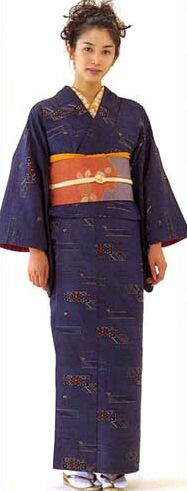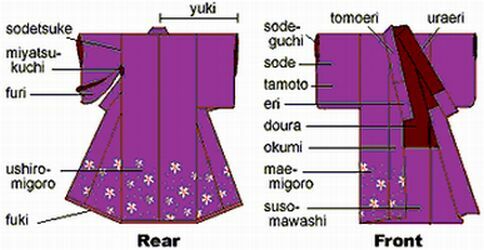

| Kimono means "clothing" in Japanese; however, it is now only used to mean tradintional Japanese clothing. |  |
RearSodetsuke - armhole |
FrontSode-guchi - sleeve opening |
Kimono Statistics Length: 158 cm Most Kimonos are made one size fits all. Obi range from 6 to 12 1/2 inches wide and 125 to 175 inches long, depending on the type. Kimonos can be made of silk, wool, cotton, linen, or synthetic cloth. Patterns can be produced by weaving, hand painting, embroidery, or use of stencils. If a kimono is dyed before the weaving process, it is called a sakizome kimono or woven kimonos. Variations include meisen or habutae (reeled silk), omeshi (heavy crepe), tsumugi (spun silk), sha (silk gauze), and ro (leno weave gauze), kasuri (splash pattern), shima (stripe pattern), koushi (checks or lattice pattern), and joufu (linen). If a kimono is dyed after weaving, it is called an atozome kimono or dyed kimonos. Variatons include garazome (dyed designs on white fabric), tegakizome (hand-painted), rouketsu (yuzen, batik), katazome (stencil), kata yuzen (hand-drawn yuzen), kata komon (small stencil designs), edo komon (small one-color crests), bingata (multicolor dyeing on stencil resist), chuugata (medium stencils for yukata), kasurizome (tie-dye), and mujizome (pattern-less, one-color dyeing). Types of kimonoKuro tomesode- a formal kimono for married women.
Kuro means black, and tomesode implies sleeves of short width. It's
usually black with designs on the bottom and lower sides. Other partsHaori - a short kimono used as a jacket. |
Obi and accessories |
|
 |
1Koshi-himo belt -is the first belt tied around the waist. It holds the kimono in place. 2.Date-jime- is the belt is the second belt tied around the kimono covering the first koshi-himo belt, it is thicker and helps make it seemless. 3.Obi - Obi is sash that used almost as a belt on a kimono. Typically ten to twelve feet long it starts at a width of six inches and ends at a foot. It is made of silk, or cotton and comes in intricate designs and colors. The obi can be tied in many forms that can take hours to create. 4.Obi-jimi- is a braided cord tied on top of the obi. it is used to keep the obi is place. Also other items possibably needed are: Obimakura: it's a pad that wraps around the waist and under the obi. It gives the Obi volume so it can hold up designs. Obiita- A stiff backing worn underneath the Obi to prevent it from getting wrinkled. |




